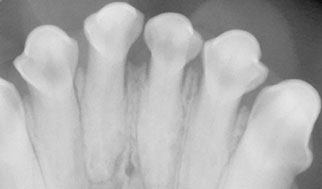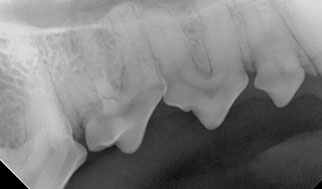Dental Radiography
The tooth you see is the “tip of the iceberg”.
The roots below the gumline tend to be longer than the crown that shows above, and some teeth have 2 or even 3 roots.


Dental x-rays let us see the unseen:
- How is the bone of the tooth socket – has it been eaten away by inflammation/infection?
- How is the enamel, the hard outer layer of the tooth? Is it being broken down, down where we can not see it? (This is especially a problem for cats).
- What does the inner pulp canal of the tooth look like? This is where the nerve and blood vessel of the tooth run; if this tissue is abnormal, the tooth may be dead or dying.
Full-mouth dental x-rays are recommended for all pets when they are under anaesthesia for a COHAT – a Complete Oral Health Assessment and Treatment. X-rays not only pick up on problems early, they give us a basis for comparison down the road.

